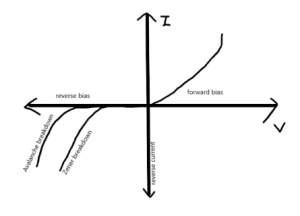Zener diode is a special type of diode that acts as a normal diode when forward biassed, but it can also be operated in a reverse biassed mode. It is like a normal p-n junction diode with the only difference that its breakdown voltage has a lower value. When the breakdown region is reached, it starts operating as a reverse biassed diode.
A typical Zener diode is made up of a semiconducting material like germanium or silicon and is heavily doped with p and n-type materials. In the normal forward biassed mode, the anode is the positive terminal, and the cathode is the negative terminal.
Zener Diode
A Zener diode is a super doped p-n junction diode that can operate in both forward and reverse bias. When it is operating in the forward bias, it is just like any other diode. Its main use is in reverse biassed mode, wherein the direction of current is reversed.
Now, most diodes are designed in a way that once a reverse voltage reaches its limit, then the diode stops functioning. So is not the case with Zener diodes. Their breakdown region is at a lower value and once that is reached, it starts conducting electricity in the reverse direction.
In the reverse biassed mode, the n-type is connected to the negative terminal and the p-type is connected to the positive terminal. When the potential across the ends is reversed and Zener voltage is reached, the p-n junction breaks down and the current starts flowing in the opposite direction.
While talking about Zener diodes, it is most crucial to understand its breakdown region. There are two breakdown regions that exist – avalanche breakdown and Zener breakdown.
Avalanche Breakdown
When the reverse voltage is applied, the depletion layer of the Zener diode starts to widen. As the value of reverse voltage increases, the width of the depletion layer also keeps on increasing. In the presence of a strong electric field, the minority carriers gain kinetic energy. As the kinetic energy keeps on increasing, electrons start colliding with other ions in the depletion layer. In the process, more free electrons are knocked out, which further collide with ions and knock out even more free electrons.
There is a sudden spike in the number and movement of free electrons in the depletion layer. This implies that there is a spike in the conductance value. At one point, known as the avalanche breakdown, there is a sharp increase in electrical conductance.
Any normal diode would not be able to tolerate such a massive spike in current within a short interval. However, the Zener diode is designed to tolerate it and to conduct electricity at high reverse potential values.
Zener Breakdown
Avalanche breakdown happens at a higher voltage value and is not very sharp. The sharper breakdown region is that of Zener breakdown and it happens at a lower reverse potential value. As mentioned above, the Zener diode is a heavily doped diode. That means the concentration of impurities in the depletion layer is much higher.
Hence, for a given value of reverse potential, the number of ions in a Zener diode would be higher as compared to that in a normal diode. Hence, the depletion layer in the Zener diode is thinner. Having a thinner depletion layer implies a higher electric field strength or higher voltage gradient. After a given point, the electrons break free from the covalent bonds and start conducting electricity. This breakdown region is known as the Zener breakdown. Zener voltage refers to the voltage at which it occurs.
I-V Plot for Zener diode

Use of Zener diode As a voltage regulator
The Zener diode has the characteristic that its voltage remains constant over a broad range of electric currents. A voltage regulator is called so because it can regulate the electrical voltage across a circuit. It ensures that the input voltage stays constant throughout the entire time period of supply. Thanks to the Zener diode, the value of voltage does not drop and remains constant even when a high power load is applied. This is a problem that used to occur a lot in olden times and still happens in rural areas.
In an electrical circuit, the Zener diode is applied in parallel with the load. A resistor is connected in series with the diode to limit the supply of electrical current across the diode. The cathode is connected to the positive terminal of the battery (or cell) and the anode is connected to the negative terminal.
Zener diodes are used in computers to ensure that there are no major voltage fluctuations as the computer machinery can be harmed if that happens. There is also a risk of fire in case of a sudden rise in voltage level.
Zener diodes are also used in power generators to ensure a steady voltage supply.
Conclusion
A Zener diode is a special kind of p-n junction diode that is operated in reverse biassed mode. While most of the normal p-n junction diodes allow the flow of current in only one direction, the Zener diode can allow both forward and reverse current to pass through it. In real life, we rely on its reverse biassed mode. There are two breakdown regions associated with a Zener diode – avalanche breakdown and Zener breakdown. Once the breakdown region is reached, the current starts flowing through the circuit in large amounts. One most important application of Zener diodes is their use as voltage regulators. This is because they have the tendency to keep the voltage constant over a broad range of currents.
 Profile
Profile Settings
Settings Refer your friends
Refer your friends Sign out
Sign out






